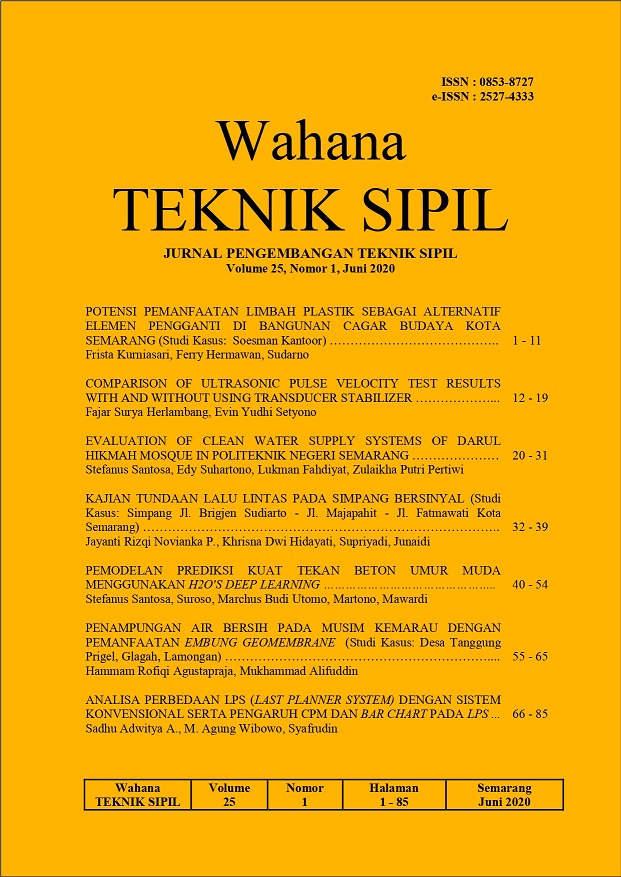PENAMPUNGAN AIR BERSIH PADA MUSIM KEMARAU DENGAN PEMANFAATAN EMBUNG GEOMEMBRANE (Studi Kasus: Desa Tanggung Prigel, Glagah, Lamongan)
DOI:
https://doi.org/10.32497/wahanats.v25i1.1918Keywords:
Reservoir, Geomembrane, Clean Water, DebitAbstract
Water is a major and important resource in the process of life in the world because of every living creature whether human, animal, and plant needs water. The technology of artificial geomembrane reservoir or water tank is the small reservoir in the village land (TKD) which is built to collect the water in the rainy season by using waterproof material as the layer by utilizing the rainwater through the river around which is then used as an alternative source of clean water (water supply) in the dry season. As for the calculation methods used for this research include: analysis of rainfall area using algebra average method (arithmetic mean), the calculation of rainfall plan can be done by using disperse measurement, with the statistical parameter of the calculation result of Sd= 23.884 Cs= 1.933 Ck= 4.031 Cv= 0.233. The distribution analysis is done using the Gumbel 1 method for 10 years plan amounted to 146.601 mm/day. Rainfall intensity analysis is done by using the Mononobe method for 10 years rainfall intensity plan amounted to 6.108 mm/hour. For the next 10 years, population projection is done using a calculation of the Arithmetic method of 2.795 populations. The conclusion of this research indicates that the clean water need in the dry season at Tanggung Prigel Village, Glagah District in 2026 is approximately 0.001941 m3/sec. While the plan for reservoir debit of 0.003254 m3/sec so it is considered sufficient to fulfill the clean water need in the Tanggung Prigel Village, Glagah District.References
Abidin, Zainal, 2010, Pemanfaatan
Potensi Air Hujan dengan
menggunakan cistern sebagai
alternatif sumber air bersih
pada gedung Department
Teknik Sipil FTUI (skripsi).
Fakultas Teknik Universitas
Indonesia
Agustapraja, H.R., 2019,
Pengembangan Konsep
Ecotourism Pada Sendang Desa
Tekerharjo, Kecamatan
Solokuro, Kabupaten
Lamongan. Jurnal Teknika,
(1), 1077-1082
Agustapraja, H.R., & Kartikasari, D.,
, Studi Evaluasi Pekerjaan
Struktur Box Culvert Pada
Proyek Pembangunan Jembatan
Kucing Ruas Sukodadi”“
Sumberwudi Kabupaten
Lamongan. Ukarst, 1(1), 80-88
Alexander dan Harahab, 2009,
Perencanaan Embung
Tambakboyo Kabupaten
Sleman DIY
Anette dan Coki, 2008, Perencanaan
Detail Embung Undip sebagai
Pengendalian Banjir Kanal
Timur
Chao-Hsien Liaw and Yao-Lung Tsai,
, Optimum Storage
Volume of Rooftop Rain Water
Harvesting System for
Domestic Use, Journal of the
American Water Resources
Association; Aug 2004; 40, 4;
Proquest Agriculture Journals
pg. 901
Kompasiana, Memanen Air Hujan
Rain Water Harvesting Sebagai
Alternatif Sumber Air
purwanti_asih_ anna_ levi /
memanen-air-hujan-rain-waterharvesting
”“ sebagai ”“ alternatif
”“ sumber ”“air _
a1c3a333117107b6600c)
Lancaster, Brad. Pemanenan air hujan
untuk lahan kering,
Vol.1.Rainsource Tekan dan 2)
Air terjun, Patricia. 2006.
Pemanenan air hujan untuk
Penggunaan Pemandangan
nd Ed , Pima County
Cooperative. Extension
Mekanisasi.litbang.deptan.go.id,
Estimasi kebutuhan air
tanaman daerah tropis
Potter, Merle C. and Wiggert D.C.,
Mechanics of Fluids.Pretince-
Hall. USA
Rekayasa Hidrologi Modul
Perhitungan ”“ Tinggi - Hujan-
Rencana ”“ Cara ”“ Kurva ”“
Gumbel - 3.doc
Sharpe, William E. and Swistock,
Bryan., 2008, Household Water
Conservation, College of
Agricultural Sciences,
Agricultural Research and
Cooperative Extension College
of Agricultural Sciences, The
Pennsylvania State University
Sosrodarsono, S., dan K. Takeda,
, Hidrologi untuk
Pengairan. Jakarta PT. Pradnya
Paramita
Thomas, Terry, tanpa tahun, Rainwater
Harvesting: Practical Action,
School of Engineering,
University of Warwick,
Coventry CV4 7AL, UK
WHO (2004), www.who.int.
Wordpress, 2008, Embung Kulak
Secang (http://sumber dayaair.
Wordpress.com/2008/04/15/
embung-kulak-secang/) diakses
pada tanggal 18 Januari 2016
Worm, Janette & Hattum, Tim van.,
, Rainwater Harvesting
For Domestic Use, Agrodok
, Agromisa Foundation and
CTA, Wageningen
Downloads
Published
Issue
Section
License
Authors who publish with this journal agree to the following terms:Authors retain copyright and grant the journal right of first publication with the work simultaneously licensed under a Creative Commons Attribution License that allows others to share the work with an acknowledgement of the work's authorship and initial publication in this journal.
Authors are able to enter into separate, additional contractual arrangements for the non-exclusive distribution of the journal's published version of the work (e.g., post it to an institutional repository or publish it in a book), with an acknowledgement of its initial publication in this journal.
Authors are permitted and encouraged to post their work online (e.g., in institutional repositories or on their website) prior to and during the submission process, as it can lead to productive exchanges, as well as earlier and greater citation of published work (See The Effect of Open Access).

